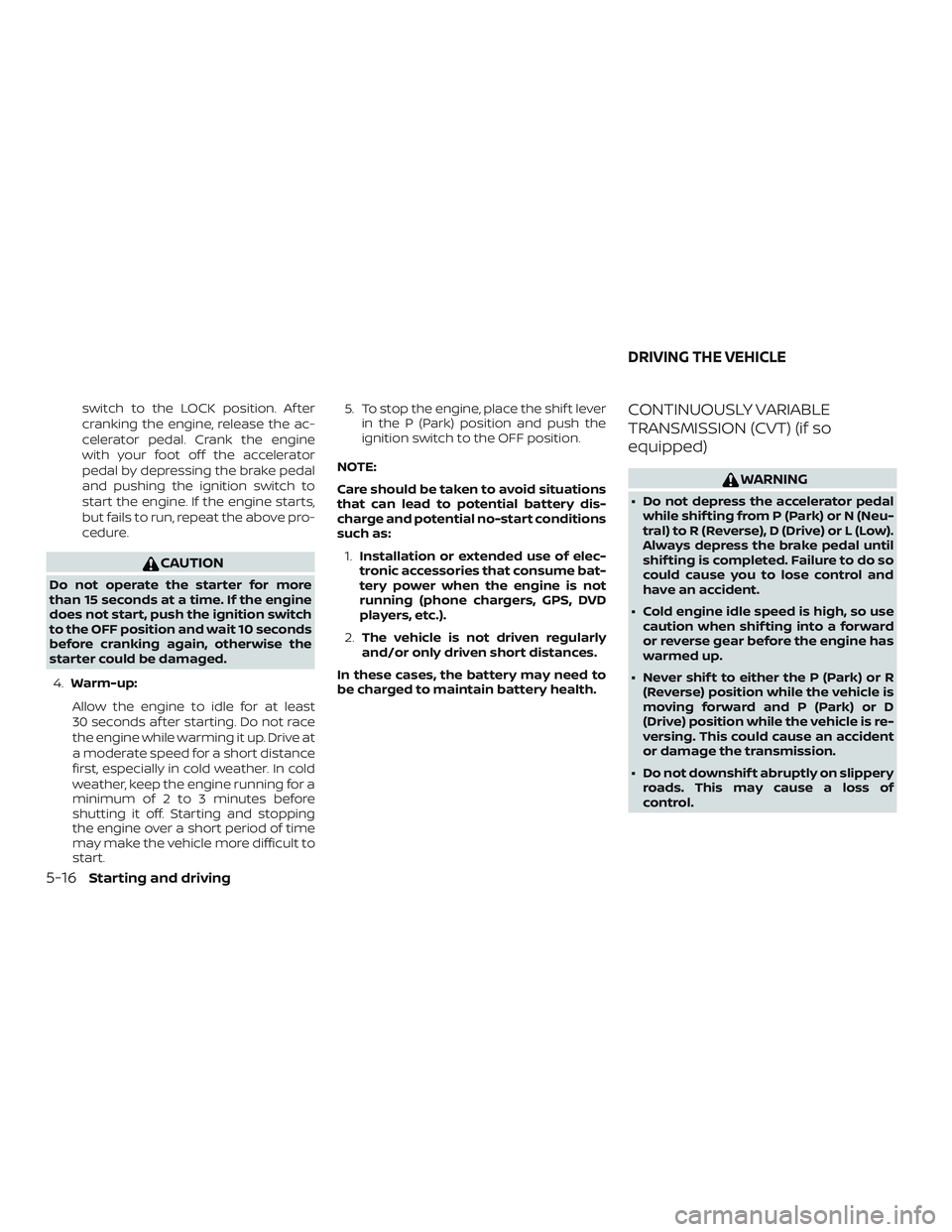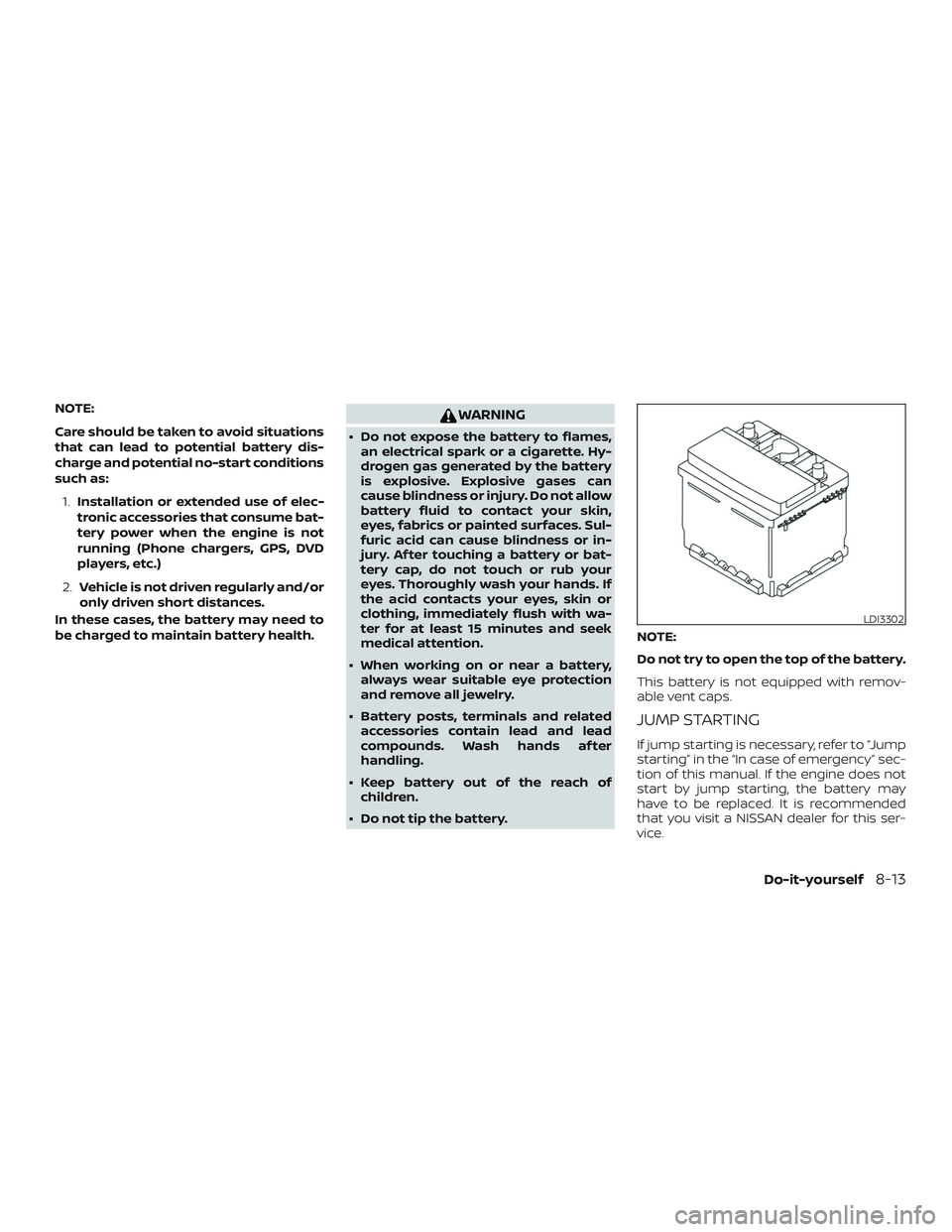2019 NISSAN VERSA SEDAN CD player
[x] Cancel search: CD playerPage 236 of 372

switch to the LOCK position. Af ter
cranking the engine, release the ac-
celerator pedal. Crank the engine
with your foot off the accelerator
pedal by depressing the brake pedal
and pushing the ignition switch to
start the engine. If the engine starts,
but fails to run, repeat the above pro-
cedure.
CAUTION
Do not operate the starter for more
than 15 seconds at a time. If the engine
does not start, push the ignition switch
to the OFF position and wait 10 seconds
before cranking again, otherwise the
starter could be damaged.4. Warm-up:
Allow the engine to idle for at least
30 seconds af ter starting. Do not race
the engine while warming it up. Drive at
a moderate speed for a short distance
first, especially in cold weather. In cold
weather, keep the engine running for a
minimum of 2 to 3 minutes before
shutting it off. Starting and stopping
the engine over a short period of time
may make the vehicle more difficult to
start. 5. To stop the engine, place the shif t lever
in the P (Park) position and push the
ignition switch to the OFF position.
NOTE:
Care should be taken to avoid situations
that can lead to potential battery dis-
charge and potential no-start conditions
such as: 1. Installation or extended use of elec-
tronic accessories that consume bat-
tery power when the engine is not
running (phone chargers, GPS, DVD
players, etc.).
2. The vehicle is not driven regularly
and/or only driven short distances.
In these cases, the battery may need to
be charged to maintain battery health.
CONTINUOUSLY VARIABLE
TRANSMISSION (CVT) (if so
equipped)
WARNING
∙ Do not depress the accelerator pedal while shif ting from P (Park) or N (Neu-
tral) to R (Reverse), D (Drive) or L (Low).
Always depress the brake pedal until
shif ting is completed. Failure to do so
could cause you to lose control and
have an accident.
∙ Cold engine idle speed is high, so use caution when shif ting into a forward
or reverse gear before the engine has
warmed up.
∙ Never shif t to either the P (Park) or R (Reverse) position while the vehicle is
moving forward and P (Park) or D
(Drive) position while the vehicle is re-
versing. This could cause an accident
or damage the transmission.
∙ Do not downshif t abruptly on slippery roads. This may cause a loss of
control.
DRIVING THE VEHICLE
5-16Starting and driving
Page 293 of 372

NOTE:
Care should be taken to avoid situations
that can lead to potential battery dis-
charge and potential no-start conditions
such as:1. Installation or extended use of elec-
tronic accessories that consume bat-
tery power when the engine is not
running (Phone chargers, GPS, DVD
players, etc.)
2. Vehicle is not driven regularly and/or
only driven short distances.
In these cases, the battery may need to
be charged to maintain battery health.WARNING
∙ Do not expose the battery to flames, an electrical spark or a cigarette. Hy-
drogen gas generated by the battery
is explosive. Explosive gases can
cause blindness or injury. Do not allow
battery fluid to contact your skin,
eyes, fabrics or painted surfaces. Sul-
furic acid can cause blindness or in-
jury. Af ter touching a battery or bat-
tery cap, do not touch or rub your
eyes. Thoroughly wash your hands. If
the acid contacts your eyes, skin or
clothing, immediately flush with wa-
ter for at least 15 minutes and seek
medical attention.
∙ When working on or near a battery, always wear suitable eye protection
and remove all jewelry.
∙ Battery posts, terminals and related accessories contain lead and lead
compounds. Wash hands af ter
handling.
∙ Keep battery out of the reach of children.
∙ Do not tip the battery. NOTE:
Do not try to open the top of the battery.
This battery is not equipped with remov-
able vent caps.
JUMP STARTING
If jump starting is necessary, refer to “Jump
starting” in the “In case of emergency” sec-
tion of this manual. If the engine does not
start by jump starting, the battery may
have to be replaced. It is recommended
that you visit a NISSAN dealer for this ser-
vice.
LDI3302
Do-it-yourself8-13
Page 326 of 372

Seats:Check seat position controls such
as seat adjusters, seatback recliner, etc., to
ensure they operate smoothly and all
latches lock securely in every position.
Check that the head restraints/headrests
move up and down smoothly and the locks
(if so equipped) hold securely in all latched
positions.
Seat belts: Check that all parts of the seat
belt system (for example, buckles, anchors,
adjusters and retractors) operate properly
and smoothly, and are installed securely.
Check the belt webbing for cuts, fraying,
wear or damage.
Steering wheel: Check for changes in the
steering system, such as excessive free
play, hard steering or strange noises.
Warning lights and chimes: Make sure all
warning lights and chimes are operating
properly.
Windshield defroster: Check that the air
comes out of the defroster outlets properly
and in sufficient quantity when operating
the heater or air conditioner.
Windshield wiper and washer*: Check
that the wipers and washer operate prop-
erly and that the wipers do not streak.Under the hood and vehicle
The maintenance items listed here should
be checked periodically (for example, each
time you check the engine oil or refuel).
Battery*: This vehicle is equipped with a
sealed maintenance free battery. It is rec-
ommended that you visit a NISSAN dealer
for service.
NOTE:
Care should be taken to avoid situations
that can lead to potential battery dis-
charge and potential no-start conditions
such as:
1. Installation or extended use of elec-
tronic accessories that consume bat-
tery power when the engine is not
running (Phone chargers, GPS, DVD
players, etc.).
2. Vehicle is not driven regularly and/or
only driven short distances.
In these cases, the battery may need to
be charged to maintain battery health.
Brake and clutch (if so equipped) fluid
level*: Make sure that the brake and clutch
fluid levels are between the MIN and MAX
lines on the reservoir. Engine coolant level*:
Check the coolant
level when the engine is cold.
Engine drive belts*: Make sure the drive
belts are not frayed, worn, cracked or oily.
Engine oil level*: Check the level af ter
parking the vehicle on a level surface with
the engine off. Wait more than 15 minutes
for the oil to drain back into the oil pan.
Exhaust system: Make sure there are no
loose supports, cracks or holes. If the
sound of the exhaust seems unusual or
there is a smell of exhaust fumes, immedi-
ately have the exhaust system inspected. It
is recommended that you visit a NISSAN
dealer for this service. For additional infor-
mation, refer to “Exhaust gas (carbon mon-
oxide)” in the “Starting and driving” section
of this manual.
Fluid leaks: Check under the vehicle for
fuel, oil, water or other fluid leaks af ter the
vehicle has been parked for a while. Water
dripping from the air conditioner af ter use
is normal. If you should notice any leaks or if
fuel fumes are evident, check for the cause
and have it corrected immediately.
Radiator and hoses: Check the front of the
radiator and clean off any dirt, insects,
leaves, etc., that may have accumulated.
9-4Maintenance and schedules
Page 361 of 372

11 Index
A
Air bag (See supplemental restraint
system) .................... .1-42
Air bag system Front (See supplemental front impact air
bagsystem)............... .1-52
Air bag warning labels ............1-60
Airbagwarninglight..........1-61, 2-19
Air bag warning light,
supplemental ..............1-61, 2-19
Air cleaner housing filter ..........8-16
Air conditioner Air conditioner operation ........4-18
Air conditioner service ..........4-23
Air conditioner specification label . .10-12
Air conditioner system refrigerant
and oil recommendations .......10-7
Air conditioner system refrigerant
recommendations ............10-7
Heater and air conditioner controls. .4-15
Servicing air conditioner ........4-23
Air flow charts .................4-19
Alarm system
(See vehicle security system) .......2-22
Anchor point locations ...........1-25
Antenna ....................4-44
Antifreeze ...................5-35
Anti-lock brake warning light ........2-14
Anti-lock Braking System (ABS) ......5-30
Audible reminders ..............2-22
Audio system .................4-23 AM/FMradio............4-28,4-30
AM radio operation
............4-30
AMradioreception............4-24
Auxiliary (AUX) devices operation . . .4-32
Bluetooth® audio .............4-39
FM radio operation ............4-31
FMradioreception............4-23
iPod®Player................4-36
iPod® player operation .........4-36
Radio ....................4-23
Steering wheel audio control switch. .4-43
USB Connections .............4-34
USBinterface...............4-33
USB (Universal Serial Bus) Connection
Port.....................4-33
Automatic Automatic power window switch . . .2-35
Automatic door locks .............3-8
B
Battery..................5-35,8-12 Charge warning light ...........2-15
Battery replacement .............8-21
Keyfob................8-21,8-22
NISSAN Intelligent Key® .........8-23
Before starting the engine .........5-14
Belt(Seedrivebelt)..............8-14
Bluetooth® audio ...............4-39
Bluetooth® hands-free phone system . .4-47 Bluetooth® connections .........4-61
Connecting procedure .........4-52 Phone indicators
.............4-51
Text messaging .............4-58
Voice commands ............4-53
Booster seats .................1-38
Brake Anti-lock Braking System (ABS) ....5-30
Brakefluid..................8-9
Brakelight(Seestoplight).......8-27
Brakesystem...............5-30
Brakewarninglight............2-14
Brakewearindicators.......2-22, 8-18
Parking brake operation ........5-23
Self-adjustingbrakes ..........8-18
Brake Assist ..................5-31
Brakefluid....................8-9
Brakes......................8-18
Brakesystem.................5-30
Break-in schedule ..............5-26
Brightness/contrast button .........4-7
Brightness control Instrument panel .............2-27
Bulb check/instrument panel .......2-14
Bulb replacement ..............8-27
C
Capacities and recommended fuel/
lubricants....................10-2
Cargo
(See vehicle loading information) .....10-13
Car phone or CB radio ............4-47
Childrestraints .......1-18, 1-19, 1-20, 1-23
Page 363 of 372

Engine oil...................8-6
F.M.V.S.S. certification label ..........10-11
Foglightswitch................2-28
Front air bag system
(See supplemental restraint system) . . .1-52
Front-door pocket ...............2-30
Frontseats....................1-2
Fuel Capacities and recommended
fuel/lubricants...............10-2
Fuel economy ...............5-27
Fuel-filler cap ................3-29
Fuel-filler door lock opener lever ....3-29
Fuel-filler lid .................3-29
Fuel gauge ..................2-9
Fueloctanerating.............10-6
Fuel recommendation ..........10-4
Loose fuel cap warning ..........2-7
Fuelefficientdrivingtips...........5-26
Fuel-filler door .................3-29
Fuel gauge ....................2-9
Fuses .......................8-18
Fusiblelinks...................8-19
G
Gascap.....................3-29
Gauge Engine coolant temperature gauge . .2-9
Fuel gauge ..................2-9
Odometer ..................2-6
Speedometer ................2-5
Tachometer .................2-8
Trip computer ................2-11
Trip odometer .............2-5,2-6 General maintenance
.............9-2
Glovebox....................2-32
H
Hands-free phone system, Bluetooth® . .4-47
Hazard warning flasher switch ........6-2
Headlight and turn signal switch ......2-25
Headlightcontrolswitch...........2-25
Headlights ...................8-25
Headrestraints .................1-6
Heater Heater and air conditioner controls . .4-15
Heater operation ..............4-17
Hood .......................3-26
Horn.......................2-28
I
Ignition switch ..................5-9
Push-button ignition switch .......5-11
Immobilizer system ...........2-22,5-14
Important vehicle information label . . . .10-11
Increasing fuel economy ...........5-27
Indicator NISSAN Intelligent Key® battery discharge
indicator...................5-13
Indicator lights and audible reminders
(See warning/indicator lights and audible
reminders) ....................2-19
Instrument brightness control .......2-27
Instrument panel .............0-6,2-2
Instrument panel dimmer switch .....2-27Intelligent Key system
Key operating range ............3-14
Key operation ................3-15
Mechanical key ...............3-4
Remote keyless entry operation ....3-19
Troubleshooting guide ..........3-24
Warning signals ..............3-24
Interiorlight...............2-35,2-36
Interiortrunklidrelease...........3-28
iPod®Player...................4-36
ISOFIX child restraints .............1-23
J
J u
mpstarting...............6-9,8-13
K
Key.........................3-2
Key fob battery replacement .....8-21, 8-22
Keyless entry With Intelligent Key system
(See Intelligent Key system) .......3-19
Without Intelligent Key system
(See remote keyless entry system) . . .3-9
Keys NISSAN Intelligent Key® .......3-3,3-12
NISSAN Vehicle Immobilizer System
keys..................... .3-5
11-3